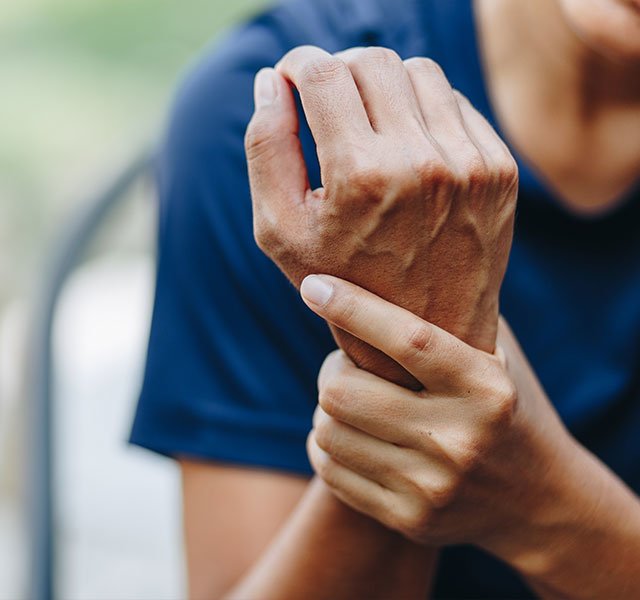The wrist has 15 bones, 17 ligaments, 24 tendons, three nerves, two major arteries — and numerous possibilities for injury.
This complex part of the body is prone to both traumatic and non-traumatic injury. Henry Ford hand surgeon Charles Day, M.D. covers common wrist injuries and what to do if you find yourself up to your wrist in pain.
Traumatic Wrist Injuries
“The majority of wrist injuries are traumatic,” says Dr. Day. “They encompass wrist fractures and damage to the ligaments.”
Fractures And FOOSH
FOOSH stands for “fall on outstretched hand.” As Dr. Day explains, “Although FOOSH isn’t the only reason for wrist fractures, it’s the major one.” Common wrist fractures include:
- Distal radius fracture: The most common type of wrist fracture, distal radius fractures occur at the end of the forearm near the wrist.
- Scaphoid fracture: Another frequent FOOSH injury — and the second-most common wrist fracture — scaphoid fractures also affect athletes. In a scaphoid fracture, one of the small bones of the wrist is fractured, causing pain below the base of the thumb. It also happens to be the one bone in the wrist that is hardest to heal after a fracture.
- Chauffeur’s fracture: Also known as radial styloid fractures, chauffeur’s fractures typically result from a hit to the radius bone near the base of the thumb.
- Ulnar styloid fracture: The ulnar styloid process is the bony projection at the end of your arm near your wrist. Symptoms of ulnar styloid fracture include pain and swelling near the outside of the wrist.
Ligament Injuries
Wrist ligament injuries can also be caused by trauma — FOOSH and otherwise. Wrist sprains are traumatic injuries to the wrist ligament. Sprains can range from a minor ligament tear that almost always heals, to a complete rupture that rarely heals without surgery. There are a number of different traumatic ligament injuries, including:
- Scapholunate ligament injury: Essential for full wrist motion, the scapholunate ligament can be stretched or torn partially or completely in a fall or if the wrist is bent backwards.
- Triangular Fibro Cartilage Complex (TFCC) injury: This structure, which stabilizes the forearm bones as the hand grasps and the arm rotates, can be injured or torn with FOOSH and wrist hyperextension.
- Lunotriquetral ligament injury: This often difficult-to-diagnose (and pronounce) injury may result from hyperextension of the wrist and FOOSH.
Non-Traumatic Injuries
Trauma isn’t the only way to injure your wrist. “Non-traumatic injuries are often due to overuse, although sometimes a medical condition may be involved,” says Dr. Day. Non-traumatic wrist injuries include:
- Carpal tunnel syndrome: This is the most common non-traumatic injury and can affect up to 10 percent of people who work in administration and manufacturing. Carpal tunnel syndrome is usually due to increased pressure in the carpal tunnel that presses on a nerve, resulting in pain, numbness and weakness.
- De Quervain’s tenosynovitis: Also known as “Mommy’s Thumb,” this type of tendonitis causes pain in the thumb, wrist and forearm. It can be the result of — you guessed it — picking up a baby. “That’s not the only cause of De Quervain’s tenosynovitis, of course,” says Dr. Day. “De Quervain’s can also occur with repetitive movements of the thumb.”
- Ganglion cyst: Ganglion cysts are more unsightly and annoying than painful or dangerous. They form when fluid leaks from a joint and the body forms a wall around it. “Ganglion cysts can be effectively, and usually permanently, removed with outpatient surgery under local anesthesia,” says Dr. Day. “However, patients can also simply live with a ganglion cyst since it is not harmful.”
- Arthritis: Arthritis causes inflammation and swelling of the body’s joints. Since the wrist is comprised of a number of joints, it’s especially vulnerable to arthritis due to a previous injury. The base of the thumb is the part of the hand most commonly affected by arthritis. Base of the thumb arthritis affects 16 percent of all women and 8 percent of all men over the age of 45. “There are a number of different types of arthritis that may affect the wrist,” remarks Dr. Day.
What To Do If You Have Wrist Pain
Your wrist is sore, difficult to move or swollen. Now what? According to Dr. Day, the first step to wrist injury treatment is likely immobilization, preventing the wrist from moving. “Unless the wrist is obviously fractured, you can begin by splinting it with a brace,” he says. “Preventing the thumb and wrist from moving will help the body begin to heal and reduce swelling. Just keep in mind that fractures and torn ligaments take six to eight weeks to heal.”
For traumatic injuries, Dr. Day recommends a spica splint, which comes up the thumb. Spica splints are particularly effective for injuries that involve the thumb or the part of the wrist closer to the thumb. For non-traumatic injuries, including tendonitis, carpal tunnel syndrome and arthritis, a wrist brace or Ace-type bandage can provide relief.
When To Seek Help
“If you have symptoms after wearing a brace for four or five days after an injury, you need professional wrist injury treatment,” Dr. Day advises. “You likely have something other than a sprain or a bruise.” For non-traumatic injuries, Dr. Day recommends making an appointment if wearing a brace doesn’t provide relief over two weeks or if pain wakes you at night.
“Continued pain, swelling, lack of mobility and other symptoms mean something is wrong,” remarks Dr. Day. “In some cases, wrist injury treatment doesn’t just provide relief. It can help you avoid permanent damage.”
To find an orthopedic surgeon at Henry Ford, visit henryford.com or call 1-800-HENRYFORD (436-7936).
Dr. Charles Day is an orthopedic surgeon who specializes in hand and wrist surgery. He sees patients at Henry Ford Hospital in Detroit and Henry Ford Medical Center Bloomfield Township.



